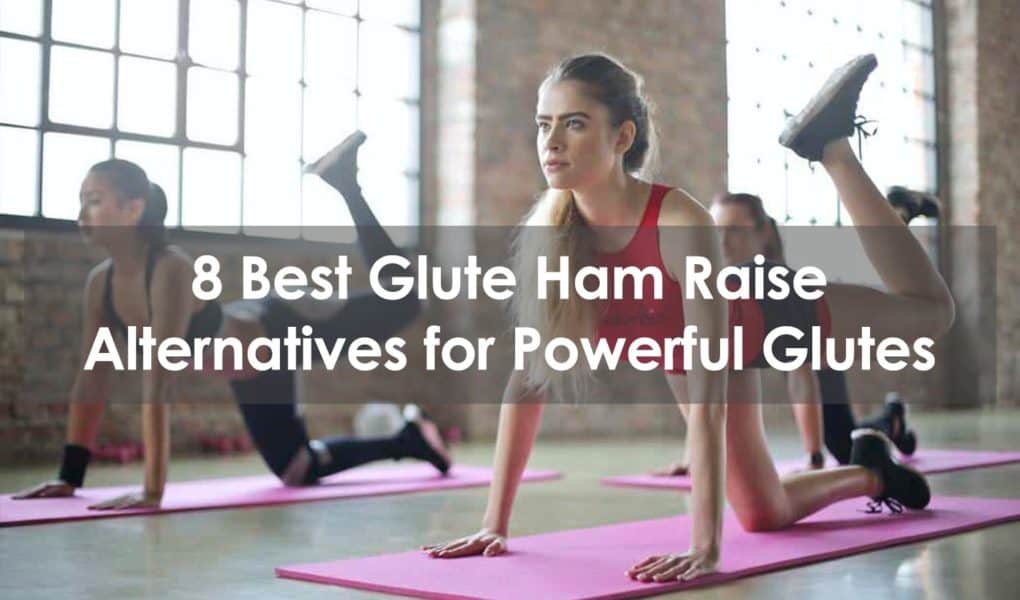Exercise, sports, and everyday life stress the back, hips, and knees. You want to strengthen these areas to insulate them from the injury and pain risk – but what do you do?
I’ve tried a lot of different exercises to strengthen and protect these muscles. Everyone worth listening to recommends glute-ham raises for both strength and health.
There are two problems:
- Glute-ham developers are rare and expensive!
- Glute-ham raises are hard: what if you can’t do one yet?
If you’re concerned about either of these, what you need is a great glute ham raise alternative.
Fortunately, this list includes 8 of the best alternatives. They’re how I’ve been getting stronger, fitter, and healthier without a glute-ham developer (GHD), and they can do the same for you…
The 8 Best Glute Ham Raise Alternatives
1. Reverse hyperextension
This is a great Glute Ham Raise alternative because it utilizes all the same muscles. The glutes and hamstrings are used for extension, though it does lean more towards the buttocks than the hamstrings.
You can also pause the reverse hyper at the top position for a more challenging, but more effective, exercise.
Equipment:
You can perform this exercise on anything stable and high enough to give you a long range of motion. The stability ball (or swiss ball) is one of the most popular choices, along with the flat bench.
How to perform:
- Set up with your core and glutes tight, holding onto a flat bench or another stable surface so your legs hang off the edge
- Press the hips into the bench while extending the legs, attempting to get them in line with or behind your body
- Hold briefly, before returning to the initial position and completing the exercise
2. Glute bridge
This is a classic – you can perform a glute bridge and get stronger with no equipment. Bridges are also great for developing effective control in the buttocks and core, which you definitely need!
How to perform:
- Lie down with a flat back and your heels close to your butt
- Keeping weight through the rear of your foot, and your core tight, drive your hips up towards the ceiling
- Pause in the top position, clenching the buttocks, before lowering back down to the starting position
Bridge variations are also amazing for scaling. The standard version is easy to perform, but you can make them harder and more effective as you improve. You can also try them with your shoulders on a swiss ball to practice your stability.
There are a few notable variations you should think about when you get stronger and need a new challenge:
· Deficit bridge: more difficult and emphasizes control and strength in the glutes.
· Single leg bridge: great for sports and keeping the hips/knees healthy.
· Weighted bridge (hip thrust): harder and a great driver of muscle and strength gains.
· Explosive bridge: great for sports and power-output.
3. Leg curl
This exercise is are all about the hamstring. Specifically, knee flexion: closing the knee joint, just like the glute-ham raise.
This makes it a perfect movement for keeping the knee healthy and ‘covering all your bases’’.
If you can’t get access to a machine, there are great alternatives.
Equipment:
You can perform bodyweight leg curls on a swiss ball, on sliders, or with resistance bands.
How to perform:
- Take your seat in a machine, attach bands to your feet, or grip the dumbbell between your feet – depending on your equipment
- Slowly move from an extended knee to a closed knee, squeezing at the end of your hamstring range
- Hold the closed position briefly, before slowly returning to the start position to end the rep
4. Back extensions
If you are struggling with glute-ham raises for strength reasons, you should try back extensions. These use the same 45- or 90-degree glute-ham developer but are easier for those with weak hamstrings.
They still offer the same kind of muscular benefits, however, in the glutes, hamstrings, and back. These help you to build the strength you need for a Glute Ham Raise without the ridiculous barrier to entry!
How to perform:
- Set up with the pad just on the bottom of your hips, so you can hinge fully to 90-degrees in the hip
- Keeping your core tight and feet pressed into the footplate, lower yourself all the way down
- Press your hips into the pad and extend the hips to straighten your body – holding for a 2-count
- Lower yourself down under control to end the rep in the starting position
5. Nordic curl
These are a brutally difficult – and effective – glute ham raise alternative. They basically cover the entire top half of the glute-ham raise. This makes Nordic curls a perfect choice when combined with reverse hyperextensions and leg curls.
How to perform:
- Hook your feet under a stable object and kneel on a cushioned or soft surface
- Start kneeling, with your core and hips active and stable – keeping a straight line from head to knee
- Lower yourself forwards, opening the knee joint until you reach the floor / a straight head-foot position
- Keeping the hips open, close the knee joint and use the hamstrings to pull yourself up to the starting position
These are very difficult, however, so you should start with an assisted Nordic curl. You can do this with a push-off or with a resistance band, for example.
Assisted Nordic curls:
6. Romanian Deadlifts
The Romanian Deadlift (or RDL) is a classic strength exercise that has built champions in all kinds of sports. It’s one of the best weight training options to replace the glute-ham raise and can be practiced with an empty bar.
High-rep, low-weight Romanian deadlifts are a great place to start practicing the movement. You can add as much weight as you want, over time, which makes the RDL appropriate whatever your strength level right now.
How to perform:
- With a barbell, stand up straight with soft knees and feet flat to the floor, at roughly hip-width
- Keeping the core tight and back flat, ease the hips back while closing them, keeping your weight in the rear of your foot
- At 90-degrees or the end of your hamstring flexibility, reverse the movement by pushing the hips forward and bringing your chest up again
7. Good morning
Good mornings are an amazing exercise for the posterior chain muscles, but they require some caution. The bar position makes them an easy site for injury if you’re not careful – or you load too quickly.
The good morning strengthens the hamstrings and hips, as well as the core and back. These are the same muscles as the glute-ham raise, but all you need is a free weight.
The movement for good mornings is exactly the same as the RDL, but with the weight located on the upper back as in a squat.
If you want to build confidence, you can try lighter front-loaded good mornings. The barbell good morning is perfect for long-term progression, but you can also use a sandbag or any other heavy object.
You should also practice paused good mornings to start with while using light weights.
8. Kettlebell Swing
The kettlebell swing is an old-school posterior chain exercise that fits all of our criteria for a Glute Ham Raise alternative. It’s a great hinging movement that builds core strength and power/control. What’s not to love?
Kettlebell swings – like the good morning and RDL – require care and good technique. They’re a hip hinge movement and you should worry about moving well before adding more weight or power.
There are very few exercises that offer the same hip and hamstring strength and power as a well-executed kettlebell swing!
How to perform:
- Stand up tall with the kettlebell in both hands, between the legs, in a hip-width stance
- Keeping the knees in one place, hinge the hips backward to bring the kettlebell back as far as your balance allows
- Keeping the back straight, push the hips forwards aggressively, swinging the kettlebell forwards and up
- Control the top of the motion – keeping the kettlebell close and your whole foot on the floor
- Continue the momentum down through the starting position and all the way back, before starting the next repetition
Related Post: 10 Best Adjustable Kettlebells with Buyer’s Guide
What makes a good glute ham raise alternative?
Glutes and/or hams: building the posterior chain
A good glute ham raise alternative needs to work the glutes and/or hams. Obviously.
It can be focused on one or the other more, but it has to work these muscles.
The posterior chain is the group of muscles including the back, buttocks, and hamstrings. An exercise that combines them in a similar way is usually going to be preferable. You don’t always need both in one. You can combine a glute-specific and hamstring-specific exercise at different times.
Hinge and/or thrust: learning to use your hips
There are really 2 movement patterns you need to train when replacing the glute-ham raise. The first is the hip hinge, and the second is the hip thrust.
These are related, but they’re not exactly the same.
The hip hinge is one of the most important movements the human body performs. Hinging is key for sports performance, as well as the health of the spine, hips, and knees.
You need to learn to hip hinge properly and practice it deliberately. To simplify: keep the torso neutral, keep the feet flat, and the knees in place, while closing and opening the hips.
Thrusting is less important but puts more of the focus on the glutes and core working together. These are important since the glutes stabilize the spine so more strength keeps the lower back safe and healthy.
Core: staying stable while you train
You need a strong and active core for these glute-ham raise exercises.
The buttocks need to be trained to stabilize the trunk in combination with the core. This is a key skill for weighted movements (like squats and deadlifts), as well as healthy aging and injury-resilience.
It’s great to get 2 benefits from a single movement. Glute ham raise substitutes that train the core are worth your time!
Frequently Asked Questions
What can I use instead of glute ham raises?
There are a few things you can use instead of a Glute-Ham Raise: bodyweight movements, free weights, and resistance machines. Bodyweight exercises like the reverse hyper and Nordic curl are great if you’ve not got much equipment.
Exercises like the good morning and RDL can help develop the hamstrings and glutes but require good technique. Poor technique will sabotage your results or provide inferior results.
Finally, some machines like the leg curl can be used to develop the hamstrings. This is important because you need to train hip flexion (closing the knee) and hip extension to replace the Glute-Ham Raise.
What muscles does the glute-ham raise work?
It’s in the name: glute-ham raises train the glutes and hamstrings. The glute-ham raise trains the entire posterior chain: back, glutes, and hamstrings. They also train the core and lower back. All these muscles stabilize the trunk.
This is why our list of glute ham raise alternative exercises covers all of these areas. They’re all important and you need to train them all to really replace the Glute-Ham Raise in your workout program.
What can I do instead of hip thrusts?
Hip thrusts and glute-hams target some of the same muscles. Fortunately, the exercise alternatives we’ve listed above also target the glutes and hams, just like a hip thrust.
Movements like the RDL and good morning, for example, are free weight glute exercises. They’re all about technique: if you perform them with control and good form, they’ll develop great hip strength!







